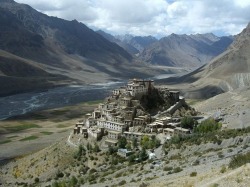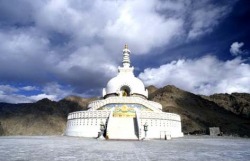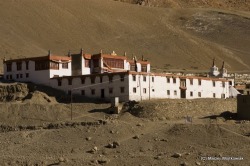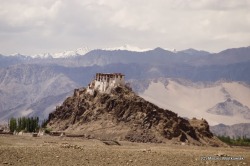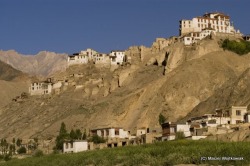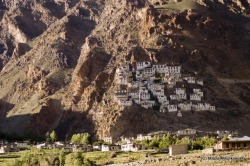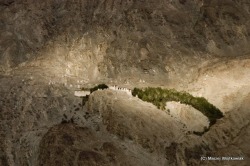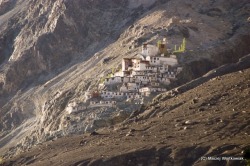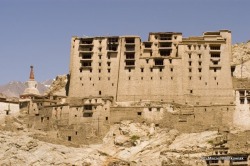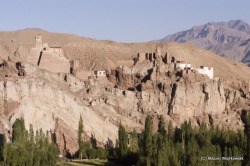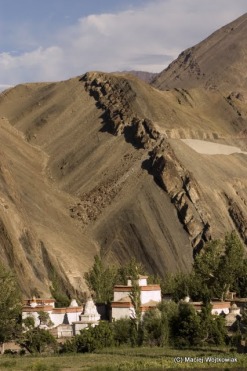Buddhism a spiritual splendor
Famous Monasteries Of Himachal and Ladakh.
Tabo Monastery - Tabo (3050 Mts) monastery is the seat of Buddhist learning, the Gompa is regarded as next in significance to the Tholing Gompa in Tibet. The Tabo monastery was established about 1000 years ago and was a part of Western Tibet School that originally designed different Mandalas in the form of the statues hanging on the walls of the monasteries. However 800 years ago with the arrival of Guru Padmasambhava in Tibet and with the instructions of his new sect, old philosophy of Western Tibet School was lost and their unique philosophical practices almost died. Now Tabo is the only living monastery outside Tibet, depicting similar Mandalas on the walls of the Dukhang.
DHANKAR (3890 mts) – About 30 km from Tabo through steep hillside along a dusty road slowly winds its way up to the village Dhankar, located at a height of 3890 mts. There situated in the middle of Ridge in a striking location, a 6th Century Gompa, though not well preserved still has some magnificent original Thankas tucked away in dark. There are some beautiful murals.
Monasteries of Charang and Kanum Among the several monastic centers founded by Rin-chen-bZangpo (Ratnabhadra, 958-1055 A.D.), quite a good number were Chos-hkors i.e., the doctrinal enclaves where facilities for diverse studies were available. The Kangyur temple at Kanum is living testimony to his academic accomplishment, Kanum itself. Means, “A place of the sacred books”.
Nako is situated about 2 km from Hangrang valley road on the Western direction of the huge mountain of Pargil. This is the highest and the largest village in the valley on the Left Bank of river Spiti. It is encircled on every side by high hills, which is a witness to the presence of former lake. The village is under the influence of Buddhism, but there are local deities, Gyalbo, Dabla and Yalso are worshiped. the village is the monastic complex of four large temples; belonging to the Dugpa order.
Lahlung
A small village consisting a cluster of 50 to 60 houses with a population over 300. The Gompa is situated on the top of the village, is invisible from the road. The main temple is decorated with unique Mandalas and statues with main statue of Bodhisattva in the center. A small but very attractive temple depicts. The monastery is over shadowed by a huge Fig tree. There is another small temple to the left of the main building, which houses a four headed clay idol of Buddha (Vairocana) looking in to four different directions.
Kye Monastery The Monastery consists of large irregular heap of low ceiling rooms and narrow corridors, interconnected by dark passages and tortuous staircases, built on what must have been a crater of an extinct volcano. This is one of the biggest and the oldest monasteries belonging to the Ge- Lug – Pa sect in Spiti. It dates back to around 14th Century and is famous for its murals, valuable books and fabulous collection of Thankas.
Kungri Monastery Kungri Monastery is believed to be founded by Guru Padmasambhava. Though now renovated into a concrete structure but interiors of the monastery tell that the Monastery must have remained an ancient monastic site of the Padmasambhava days. Generally the Tibetan monasteries are built in a compact layout with all temples and apartments put together. But the Kungri Monastery is formed of three detached rectangular blocks facing due East. The Lhakhang being on the higher terrace on the North followed by Sampup – Chos – Ling in the middle and compact structure Tangyur and Gokhang. This belongs to the Nigma Pa sect. Buddhist Tantra called Bhusang. The villages of Sagnam , Mud Tilling are beautifully set amidst the valley.
Villages of Langja , Hikkim and Komik These Villages are all situated over the height of 4000 Mts. With striking locations and house some of the most interesting monasteries in the Spiti Valley . The ancient Monastery of Hikkim also known as the tangyug Gompa is of unique importance as this is one of the two Sakya Pa Monasteries In Spiti Valley second being situated at Kaza. This Monastery was responsible for the revision or propagation of Tantra teachings during the 14th Century.
Keylong is the district head quarters of Lahaul and Spifi. At an altitude of 3156 m. Keylong is situated on the main trade route between the Rohtang and Baralacha passes above the Bhaga river.
Three of the best known monasteries Tayul, Kardang and Sha-Shur are within a few kms. from Keylong
Hemis
The 17th century monastery of Ladakh, Hemis is also the largest one in the region. 45 km south of Leh, it belongs to Brokpas, the red sect. Unique in its own sense, this monastery is both splendid and majestic. An annual festival is held here in June or July for two days commemorating the birth anniversary of Guru Padmasambhava.
Thiksey
20 km from Leh, Thiksey is one of the most beautiful monasteries of Ladakh. Situated above a hill, it belongs to Gelukpa order. Paldan Sherab, founded 12-storey monastery complex featuring stupas, statues, thankas, wall paintings, . Its main prayer hall has 15m high statue of seated Buddha.
Likir
52 km from Leh, it was founded in the 11th century. The highlights of the monastery are huge clay images of Buddha, old manuscripts; a rich collection of thankas
Spituk
18 km from Leh, Spituk Gompa is situated atop the hill. Rinchen Zangpo gave the gompa its present name.The gompa features an interesting collection of ancient masks, arms, icons and thankas.
Lamayuru
125 km west of Leh, the 10th century Lamayuru monastery is now mostly in ruins. According to legend, Lamayuru was once a lake, whose water receded up to the mountains when blessed by a Lama to vacate the site for the monastery to be built. Today, only the main hall has survived featuring a number of thankas .Lamayuru has man-made caves in its mountains.
Shey
15 km from Leh, Shey monastery is the former redidence of the royal family. It features 12 ft high statue of Shakyamuni Buddha made by copper guilt and another statue of Buddha, which is three-storeys high. Also known as Dresthang Gompa , it is adorned with stone carving and chortens scattered around it.
DHANKAR (3890 mts) – About 30 km from Tabo through steep hillside along a dusty road slowly winds its way up to the village Dhankar, located at a height of 3890 mts. There situated in the middle of Ridge in a striking location, a 6th Century Gompa, though not well preserved still has some magnificent original Thankas tucked away in dark. There are some beautiful murals.
Monasteries of Charang and Kanum Among the several monastic centers founded by Rin-chen-bZangpo (Ratnabhadra, 958-1055 A.D.), quite a good number were Chos-hkors i.e., the doctrinal enclaves where facilities for diverse studies were available. The Kangyur temple at Kanum is living testimony to his academic accomplishment, Kanum itself. Means, “A place of the sacred books”.
Nako is situated about 2 km from Hangrang valley road on the Western direction of the huge mountain of Pargil. This is the highest and the largest village in the valley on the Left Bank of river Spiti. It is encircled on every side by high hills, which is a witness to the presence of former lake. The village is under the influence of Buddhism, but there are local deities, Gyalbo, Dabla and Yalso are worshiped. the village is the monastic complex of four large temples; belonging to the Dugpa order.
Lahlung
A small village consisting a cluster of 50 to 60 houses with a population over 300. The Gompa is situated on the top of the village, is invisible from the road. The main temple is decorated with unique Mandalas and statues with main statue of Bodhisattva in the center. A small but very attractive temple depicts. The monastery is over shadowed by a huge Fig tree. There is another small temple to the left of the main building, which houses a four headed clay idol of Buddha (Vairocana) looking in to four different directions.
Kye Monastery The Monastery consists of large irregular heap of low ceiling rooms and narrow corridors, interconnected by dark passages and tortuous staircases, built on what must have been a crater of an extinct volcano. This is one of the biggest and the oldest monasteries belonging to the Ge- Lug – Pa sect in Spiti. It dates back to around 14th Century and is famous for its murals, valuable books and fabulous collection of Thankas.
Kungri Monastery Kungri Monastery is believed to be founded by Guru Padmasambhava. Though now renovated into a concrete structure but interiors of the monastery tell that the Monastery must have remained an ancient monastic site of the Padmasambhava days. Generally the Tibetan monasteries are built in a compact layout with all temples and apartments put together. But the Kungri Monastery is formed of three detached rectangular blocks facing due East. The Lhakhang being on the higher terrace on the North followed by Sampup – Chos – Ling in the middle and compact structure Tangyur and Gokhang. This belongs to the Nigma Pa sect. Buddhist Tantra called Bhusang. The villages of Sagnam , Mud Tilling are beautifully set amidst the valley.
Villages of Langja , Hikkim and Komik These Villages are all situated over the height of 4000 Mts. With striking locations and house some of the most interesting monasteries in the Spiti Valley . The ancient Monastery of Hikkim also known as the tangyug Gompa is of unique importance as this is one of the two Sakya Pa Monasteries In Spiti Valley second being situated at Kaza. This Monastery was responsible for the revision or propagation of Tantra teachings during the 14th Century.
Keylong is the district head quarters of Lahaul and Spifi. At an altitude of 3156 m. Keylong is situated on the main trade route between the Rohtang and Baralacha passes above the Bhaga river.
Three of the best known monasteries Tayul, Kardang and Sha-Shur are within a few kms. from Keylong
Hemis
The 17th century monastery of Ladakh, Hemis is also the largest one in the region. 45 km south of Leh, it belongs to Brokpas, the red sect. Unique in its own sense, this monastery is both splendid and majestic. An annual festival is held here in June or July for two days commemorating the birth anniversary of Guru Padmasambhava.
Thiksey
20 km from Leh, Thiksey is one of the most beautiful monasteries of Ladakh. Situated above a hill, it belongs to Gelukpa order. Paldan Sherab, founded 12-storey monastery complex featuring stupas, statues, thankas, wall paintings, . Its main prayer hall has 15m high statue of seated Buddha.
Likir
52 km from Leh, it was founded in the 11th century. The highlights of the monastery are huge clay images of Buddha, old manuscripts; a rich collection of thankas
Spituk
18 km from Leh, Spituk Gompa is situated atop the hill. Rinchen Zangpo gave the gompa its present name.The gompa features an interesting collection of ancient masks, arms, icons and thankas.
Lamayuru
125 km west of Leh, the 10th century Lamayuru monastery is now mostly in ruins. According to legend, Lamayuru was once a lake, whose water receded up to the mountains when blessed by a Lama to vacate the site for the monastery to be built. Today, only the main hall has survived featuring a number of thankas .Lamayuru has man-made caves in its mountains.
Shey
15 km from Leh, Shey monastery is the former redidence of the royal family. It features 12 ft high statue of Shakyamuni Buddha made by copper guilt and another statue of Buddha, which is three-storeys high. Also known as Dresthang Gompa , it is adorned with stone carving and chortens scattered around it.
